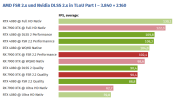This thread is wild. Just find a reviewer you like and stick to it. If you like HU content, use it for your decision making, if you don’t like it, don’t use it, don’t read it, don’t watch it etc.
I don’t like the term reconstruction. All rasterized images are under-sampled. The trick is using your compute budget smartly to use more samples in the right places. TAA uses samples from previous frames. So do DLSS and FSR2. DLSS uses a trained network to select samples. FSR2 uses an algorithm. The difference between TAA and DLSS/FSR2 is DLSS and FSR2 include an upscale. They’re all constructing the current frame with temporal samples. There’s no “reconstruction.” So DLSS and FSR2 just have fewer samples per pixel than native with TAA. Some people prefer lowering settings instead of adding DLSS or FSR. I do both because I don’t do peasant gaming at 30 or 60 fps.
I don’t like the term reconstruction. All rasterized images are under-sampled. The trick is using your compute budget smartly to use more samples in the right places. TAA uses samples from previous frames. So do DLSS and FSR2. DLSS uses a trained network to select samples. FSR2 uses an algorithm. The difference between TAA and DLSS/FSR2 is DLSS and FSR2 include an upscale. They’re all constructing the current frame with temporal samples. There’s no “reconstruction.” So DLSS and FSR2 just have fewer samples per pixel than native with TAA. Some people prefer lowering settings instead of adding DLSS or FSR. I do both because I don’t do peasant gaming at 30 or 60 fps.


